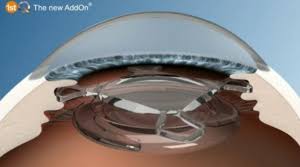In recent years, the technology in the world of intraocular lens surgery has advanced very significantly. Before these lenses existed, all patients who underwent cataract surgery needed glasses for near vision and far vision. After the appearance of the first monofocal lenses, a good visual acuity was achieved from afar, but in general, glasses were necessary for the correction of presbyopia. After many years of evolution, the astigmatism corrective toric lenses came out and the change in the customs of the population, with the introduction in our daily work of tablets, mobiles and computers, the need to have a good visual acuity has increased, and for most patients this is increasingly important. So when the first multifocal lenses appeared on the market, there was a great revolution that over the years offers more advantages to users. At present, premium lenses are quintessentially trifocal intraocular lenses. This proven success has such acceptance that when a patient is going to have crystalline eye surgery, after a rigorous study with optical biometrics, topography, retinal OCT and tear study, it is determined if he is a candidate for this type of lens trying not to wear glasses at any distance.
But … What happens to patients who have undergone cataract surgery a few years ago and had a monofocal lens implanted? Is it possible that there is some technique that allows them to have better near vision and thus not have to wear reading glasses ?.
Until recently it was not possible. However, but only a few months ago, the Rayner laboratory has presented new lenses for people who have previously undergone surgery and who provide this option. Until recently it was not possible. However, the Rayner laboratory, a few months ago, has introduced new lenses for people who have previously undergone surgery and who provide this option. It is a type of AD-Onn lens, specially created to be placed on top of the old intraocular lens that the patient has implanted. Instead of introducing the lens into the capsular bag as is done with the rest of the lenses, they are implanted in sulcus, just the space between the old lens and the iris. These lenses have special characteristics. They are larger, and have longer haptics that make them very stable once they are implanted inside the eye, and the offsets are avoided. Although these types of Ad-onn lenses have been known for some time, the trifocal option is relatively new, since the old lenses were bifocals and did not achieve good intermediate vision. All these lenses are indicated to reduce residual refractive defects that sometimes appear as refractive surprise after surgery of this type, and also for patients who have had cataract surgery for years and long to see closely without correction.
These lenses are implanted by surgery with local anesthesia and as an outpatient since they do not need hospitalization. The process of this surgery is about ten minutes and usually has a rapid recovery.


Recent Comments